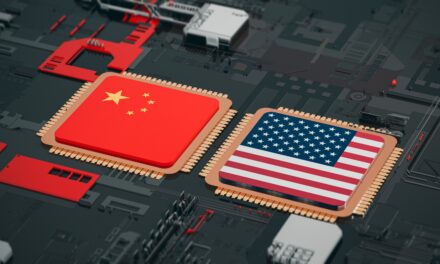Over the past few months I’ve noticed more social media posts like this one:

And headlines like this one from Motor Trend:

The truth is, China is producing EVs at a phenomenal rate, and Chinese manufacturers are selling these vehicles for a fraction of the cost of electric vehicles in the U.S.
That said, I don’t think Chinese EV dominance is as big a problem as this headline might suggest.
But there’s a larger issue here that we need to address.
For decades, the U.S. held the crown as the world’s leading manufacturing powerhouse.
But today, that title belongs to China.
And the gap between the two countries has grown to staggering proportions.
According to data from the OECD’s Trade in Value Added (TiVA) database, China’s manufacturing output surpasses that of the next nine largest manufacturing nations combined.

That might shock you.
It should definitely concern you. Because the U.S. has been struggling to keep up, and its share of global manufacturing keeps shrinking.
What can we do about it?
To answer that question, we need to understand how we got here in the first place.
Rising China
China’s rise in manufacturing has been nothing short of meteoric.
In 1995, its manufacturing output was comparable to that of countries like Canada and the U.K. Just a decade later, it had surpassed Japan.
By 2008, it overtook the U.S.
Since then, China’s share of global manufacturing has doubled, while the U.S.’s share has continued to decline.
By 2020, China accounted for around 35% of total global manufacturing output, three times more than the U.S.
To put that into perspective, China now produces more manufactured goods than the next nine largest countries combined…
Including the U.S., Japan, Germany, India and South Korea.

How did this happen?
China had the room, manpower and financial incentive to rapidly grow its manufacturing sector.
What’s more, the Chinese government relentlessly pursued this goal.
For years, China benefited from lower labor costs. But even as wages have risen, its well-developed supply chains and economies of scale have kept production costs competitive.
Massive infrastructure investments have also strengthened China’s position.
Roads, ports and power grids have been built to support its factories, allowing raw materials and finished products to move efficiently.
And while China’s early success was driven by exports, the growth of its middle class has fueled domestic demand.
This cycle of growth and increased demand means China’s industrial output keeps growing.
And policies like “Made in China 2025” are meant to ensure its continued manufacturing dominance by shifting production toward high-tech industries.
What Happened to Manufacturing in the U.S.?
While China was rapidly expanding its manufacturing sector, the U.S. was moving in the opposite direction.
Many U.S. companies moved production overseas to take advantage of lower costs, particularly in China.
This shift hollowed out domestic manufacturing capabilities.
And unlike China, the U.S. has not invested heavily in modernizing its transportation and industrial infrastructure.
Aging roads, outdated ports and an overburdened power grid make domestic manufacturing less competitive.
U.S. wages have remained higher than China’s, but automation and robotics have only filled a fraction of lost manufacturing jobs.
As a result, American factories often struggle to compete on both cost and efficiency.
One of the biggest problems we face in the U.S. is that our manufacturing policy has been inconsistent at best. Different states and industries often pursue their own priorities.
Unlike China, we lack a unified national strategy.
But perhaps the biggest factor hurting U.S. manufacturing is how much our country now relies on Chinese production.
The U.S. is about three times more dependent on Chinese manufacturing than China is on the U.S.
This imbalance means that any disruption in China’s production — like we experienced during the COVID shutdowns — can have devastating consequences.
And despite increasing political rhetoric about “decoupling” from China, the reality is this would be costly and extremely difficult.
All major manufacturing nations, including the U.S., source at least 2% of their industrial inputs from China.
Cutting these ties would require massive restructuring and increased production costs.
It would also likely take us years to transition away from our dependence on Chinese goods.
Here’s My Take
I know this might sound hopeless. But I see it as an opportunity.
Rebuilding America’s manufacturing sector won’t be easy, but it’s not impossible.
As technologies like artificial intelligence and robotics allow us to do more with less, we’ll find more efficient ways to produce goods here in the United States.
To me, it goes hand in hand with our race against China to achieve artificial super intelligence (ASI) first.
In other words, to compete with China the U.S. will need to adopt a more strategic and coordinated approach.
That means we need to prioritize industries where we can maintain a technological edge, such as semiconductors, aerospace… and, yes, even electric vehicles.
Reshoring these critical industries can help reduce our dependence on China.
Modernizing our infrastructure should also be a top priority. Upgrading our transportation networks, power grids and industrial facilities will help make us more competitive.
Fortunately, the tide seems to be turning.
Since returning to office in January 2025, the Trump administration has taken some bold steps to make U.S. manufacturing great again.
Tariffs on foreign imports have been reinstated and expanded, including a 25% tariff on steel and aluminum. A new 10% baseline tariff on all foreign-made goods has been proposed, alongside a 60% tariff on Chinese imports.
And I know tariffs are controversial, but they’re meant to grow the economy while protecting U.S. jobs. Although it’s still unclear how these tariffs will play out.
But the tax incentives introduced by the Trump administration to encourage domestic manufacturing seem like an immediate win.
Apple just announced that it will invest $500 million in U.S. manufacturing over the next four years. So it appears this initiative is already paying off.

A review of U.S. trade policy is also underway, with federal agencies evaluating how to strengthen domestic production.
These moves mark a significant — and welcome — shift in America’s approach to manufacturing policy.
I’m also banking on the Trump administration to leverage the Defense Production Act to boost industrial capacity in critical sectors.
This will ensure that key technologies and materials are produced within the U.S., and it will be a major factor in protecting our AI superiority.
Of course, time will tell if these initiatives will be enough to close the manufacturing gap with China.
But I believe they represent a renewed effort to restore the U.S. as a global manufacturing leader.
And with China’s global market share beginning to plateau…
That’s something we can build on.
Regards,

Ian King
Chief Strategist, Banyan Hill Publishing









